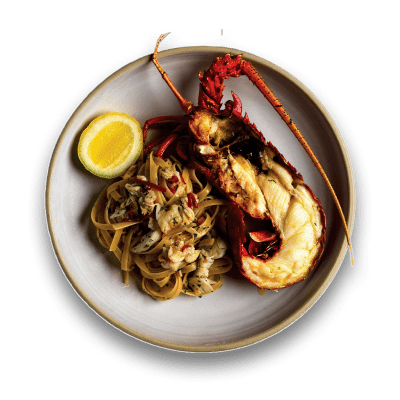


Western Rock Lobsters are part of the spiny lobster family which get their name from the hundreds of tiny forward-pointing spines that cover their head and body. They have two large antennae protruding from their head which serve as a navigation and communication tool as well as a defence weapon. The shell may be from deep maroon to a light red, with some white and pale lobsters in early Summer. The shells turn bright red when cooked.
Western Rock Lobster flesh is translucent when raw. When cooked, the flesh becomes white and opaque with orange tinges on the skin.
Western Rock Lobster flesh is firm, with a sweet medium and rich taste, with a pronounced crustacea flavour of prawn and scallop. The aroma is reminiscent of seaweed with a sweet iodine zing on the palate
The texture of raw Western Rock Lobster is creamy and rich, when cooked it has a crisp, firm texture, which should soften easily in the mouth – unless overcooked
Steam, poach, deep-fry, pan-fry, stir fry, bake, grill, or barbecue Western Rock Lobsters or serve the flesh raw (sashimi). Undercook Western Rock Lobster and allow to “rest” prior to eating, as they will continue cooking in the residual heat, if overcooked, the meat will be tough and leathery with a loss of the natural sweet flavour. Use the shell to flavour stocks, soups and sauces. Western Rock Lobsters have excellent presentation potential, so take care not to damage the legs and head when preparing or cooking.
Vivid white, glossy flakes. Crab like and fresh ocean some cooked vegetable. Slightly crisp, extremely tender, melt-in-mouth. Intensely sweet ocean notes, crab-like and savoury with lingering, light umami and sweet notes.
Vivid white flakes. Complex and intense aroma of fresh ocean, crab like with roasted vegetable notes. Slightly crisp, melt-in mouth tender. Intensely crab-like, sweet ocean, savoury, light spring vegetal notes. Savoury flavour persists on the back palate
Adding butter or olive during or after the cooking process increases the luxurious mouthfeel or the f lesh and helps carry the flavours through to the back palate, increasing the length of the f lavour and palate weight.
Adding spice from chili or pepper warms the palate and increases the f loral, herbaceous notes of the lobster. A delicate approach to heat is the best way to add warmth and to not over power the delicate f lavour of the Lobster.
Umami can be added using soy, or seaweed products such as kombu. The umami addition increases the vegetal and savoury elements of the Lobster and adds to the richness and length of the f lavours on the palate.
Adding salt to Lobster accentuates the natural sweetness and crustacean f lavour of the flesh. Chef tip is to salt the Lobster after it is cooked to avoid excess moisture loss during the cooking process.
Adding a squeeze of citrus or a tangy vinaigrette after cooking lightens and brightens the flavour of the Lobster and accentuates the zingy minerality of the flesh. Adding citrus or vinegar to sashimi lobster can add a light cure that changes the texture of the raw flesh, relaxing the muscle fibres and softening the texture.